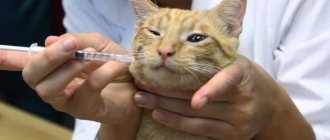Chlamydia in cats is completely different in its clinical picture and mode of transmission from a similar sexually transmitted disease in humans. The intracellular microorganism that causes this pathology in animals is infectious in nature. The virus is not only extremely dangerous, but also threatens serious complications, as well as death, if you do not start treating your pet in time.
The causative agent of chlamydia in cats
Microorganisms that cause zooanthroponotic (common to humans and animals) chlamydia in cats are called chlamydia. These are small intracellular parasites that are something between a bacterium and a virus. This is due to the peculiarities of their structure and complex life cycle:
- Outside the cells, microbes are in the state of an elementary body. They have a spherical membrane with genetic information located inside. This is necessary for the spread of infection within the body.
- Reticular bodies formed when the parasite enters develop and divide. The pathogen does not show increased activity, so it goes undetected by the immune system for some time.
- Intermediate bodies acquire the characteristic features of elementary and reticular viral parasites.
There are different types of these pathogens; for cats, the most dangerous forms are chlamydophila felis, which reproduce by division within the body.
Peak activity of chlamydia in cats is demonstrated by inflammatory conjunctivitis. And if the immune system is severely weakened, then there will be a high risk of developing complications in the form of respiratory ailments. There is no urogenital subtype of the virus for cats, but bacteria can often be found in the urinary system or intestines.
Various studies by scientists have found that about 30-60% of domestic animals are carriers of a pathogenic microorganism throughout their lives, but only a few get sick. In most cases, we can talk about an asymptomatic form. However, the absence of any signs of illness does not mean that the animal is safe.
Chlamydia in cats is not dangerous for people. A similar disease in humans is caused by another type of parasite – chlamydia trachomatis, which is transmitted exclusively through sexual contact. This form has nothing to do with the pathogen in cats. And myths about infertility or miscarriages caused by infection from a mustachioed friend are pseudo-scientific horror stories. The only trouble with this disease for a person is conjunctivitis, which can disappear without a trace in a week.
Diagnosis of the disease
To diagnose chlamydia, a physical examination is done to look for symptoms of the disease. A urine sample is taken, a swab is taken from the genitals (cervix, urethra), as well as from the throat or rectum.
It is based on molecular genetic and immunological research methods:
- PCR. The most accurate and sensitive method. The analysis is based on the results of scrapings or urine samples (only the morning portion is taken). Allows you to determine the DNA of the pathogen from the first days of infection.
- ELISA. The method is based on the detection of antibodies. Allows you to confirm the presence of bacteria and the stage of development of the disease. Efficiency is no more than 50%. Immunoglobulins of class G, A, M, IgG, IgM, IgA can be present in the blood of patients after an infection or as a result of cross-reactions with respiratory chlamydial diseases.
- Cultural method (culture for chlamydia). Determines sensitivity to antibiotics. The most labor-intensive and expensive diagnostic method. You have to wait 3-4 days for results. The advantage is that culture can determine the most effective drug.
Methods of infection
Most often, pets that come into contact with stray animals become infected. Chlamydia can live for up to two days outside the host's body in a dark, warm, damp environment. In the sun they quickly die. High-risk areas include veterinary hospitals, exhibitions, shows, homeless shelters, nurseries, basements, and public places.
Cats become infected as follows:
- through the soles of shoes, outer clothing, or the hands of a person who has had contact with the carrier animal;
- from tear fluid, excrement of a sick individual;
- through bedding, wool or grass on which an infected person walked some time ago;
- by airborne droplets from direct contact;
- sexual transmission, not confirmed by scientific research.
Cats become infected by hunting birds, mice, or through contact with feces, saliva and urine of an infected rodent or bird. In laboratory conditions, it has been established that from the moment the pathogenic microorganism penetrates the conjunctiva until the first symptoms of illness appear, 3 to 5 days pass.
In the natural outdoor environment, the incubation period for feline chlamydia increases on average to two weeks. The virus lives in the external environment for about a day and a half. Pathogens die in a couple of minutes if they get into boiling water.
The following can also destroy a harmful pathogen:
- exposure to ultraviolet rays;
- chloramine;
- phenol.
Penetrating into the body, feline chlamydia enters the epithelial cells of the mucous membrane of the stomach, intestines, bladder, oral cavity, pharynx, and conjunctiva. There it begins to destroy organ protection and multiplies rapidly. This occurs due to binary fission. Young, elderly or immunocompromised animals get sick much more quickly.
The parasite spreads to the reproductive system only in a third of cases. If a pregnant female with feline chlamydia gives birth during the acute period, the offspring may be infected. This form is called neonatal. Infection occurs at the moment when the fetus moves through the birth canal. The first day the babies look healthy, but their eyes do not open for some time. After a couple of days, it becomes clear that the eyelids are glued together with purulent discharge appearing from the corners of the eyes.
Neonatal chlamydia in a kitten causes a severe respiratory complication, but it most often goes away within a week after adequate treatment. The lack of drug therapy, even if the cubs survive, entails lifelong blindness. That is why breeding individuals are tested before each mating for the presence of feline chlamydia in the body of the future parents.
Causes of chlamydia
Infection with chlamydia most often occurs through sexual contact through unprotected sexual contact; in rare cases, household infection is also possible due to poor hygiene standards - for example, in a swimming pool or sauna, as well as when using shared towels or utensils. In humid conditions and at room temperature, chlamydia can survive on household objects for up to two days. If a pregnant woman has chlamydia, the infection can be transmitted to her unborn baby: the child can become infected in utero or during childbirth. There is also the concept of a “chlamydial family,” when both parents are infected with chlamydia, and this becomes the cause of household contact infection of children.
Unfortunately, even after treatment, the body does not develop effective immunity to Chlamydia trachomatis: if precautions are not taken, chlamydia can become infected again.
Forms of chlamydia in cats
The manifestation of the disease does not begin from the very first day after infection, but after 5-10 days. Veterinarians distinguish acute and chronic forms of chlamydia in cats. Periods of exacerbation, or relapse, and attenuation, or remission, are also recorded.
Latent species
Good immunity helps the animal to vigorously fight the microbe. Therefore, the disease can occur in a hidden or, in other words, latent form. Initially, there is a fever that lasts 2-3 days. In general, the pet's condition is satisfactory. Appetite remains normal, activity does not decrease. If the eyes are a little watery, the owner will most likely think of a cold.
The first two weeks, conjunctivitis appears in one eye, then the inflammation spreads to the second organ of vision. The mucous membrane of the eyelids swells and turns red. This can last from several days to a couple of months.
Pneumonia with this type of chlamydia in cats is extremely difficult to diagnose because small peripheral areas of the lungs become inflamed. In this case, breathing is almost not affected. Only a histological examination performed in a veterinary clinic will help determine a pulmonary disease.
The reproductive system is also subject to pathology: cervicitis develops, that is, inflammation of the cervix, urethritis, and miscarriages occur in pregnant females. Males experience orchitis, or inflammation of the testes, as well as balanoposthitis of the glans penis.
Acute and chronic types
With chronic manifestations of chlamydia in cats, the listed signs are invisible, so it is very difficult to guess about the disease. Due to the lack of a clear clinical picture, the pet will be a carrier, and no one will guess about it.
In the acute form, the manifestations of feline chlamydia are much more noticeable. Unfortunately, not all owners attach importance to this. Over time, complete attenuation occurs, and then transition to the chronic type.
Treatment of complicated chlamydia
Chlamydia is considered complicated if inflammatory diseases of the pelvic organs develop against its background: salpingitis, endometritis and others. In such cases, the drugs of choice are oral ofloxacin or levofloxacin, either as monotherapy or in combination with metronidazole. An alternative treatment regimen includes a parenteral single dose of a second or third generation cephalosporin, followed by a course of doxycycline with or without metronidazole.
Symptoms of chlamydia in a cat
When chlamydia enters the body, it causes conjunctivitis, that is, suppuration of the mucous membrane of the front and inner part of the eyes. They begin to behave like intracellular parasites.
Eye inflammation
The pathogen penetrates the epithelial cells of the conjunctiva. It develops, destroying tissue, and purulent discharge appears. Clinical signs can be diagnosed only after 5-6 days. First one eye is affected, after 2 days both are affected.
The symptoms are severe: in addition to pain and discomfort, involuntary contraction of the eyelid appears. The mustachioed friend can hardly open his eyes, and there is severe swelling. Often the third eyelid swells so much that it bulges out.
Other symptoms:
- severe sneezing;
- cough;
- labored breathing;
- runny nose.
Thick yellow-green discharge flows from the nose and eyes. They dry quickly, forming a crust that is not recommended to be touched. Wanting to help, the owner risks damaging the soft tissues of these organs.
Respiratory view
This manifestation of chlamydia in cats is not considered typical, and it is rare. Veterinarians often misidentify it as bacterial pneumonia. Indeed, the clinical picture of chlamydial pneumonia is almost no different from ordinary pneumonia.
Signs may be the following:
- apathy;
- refusal to eat;
- high body temperature;
- cough.
The cough is initially hard and barking. Over time, it softens, it seems that something is gurgling in the chest. In the absence of timely treatment, sepsis develops. In such cases, the body temperature decreases, then the cat falls into a coma.
Chlamydial arthritis
The first reported case of such arthritis was described in 1999. Therefore, the pathogen has not yet been fully studied. Kittens and young animals are most at risk of becoming infected. However, cases of the disease have been identified regardless of age and breed.
Gastrointestinal disorders
With this type of infection, problems with the gastrointestinal tract rarely occur, although the accumulation and growth of harmful microorganisms occurs there. The main problem of gastrointestinal chlamydia is its asymptomatic course. In almost all cases, the appetite of infected animals is preserved, and the stool has a normal consistency. In this case, only laboratory tests can detect the disease.
Genitourinary disorders
Sexual chlamydia also does not have pronounced symptoms, although in approximately 30% of infected cats, chlamydia affects the reproductive and urinary systems. In some cases, owners note a pinkish discharge from the cat’s vagina; in males, the symptoms are more difficult to notice. The maximum that you can pay attention to is the constant licking of the genitals.
In unsanitary conditions, living in crowded conditions, in poorly ventilated areas, the spread of the virus occurs very quickly. So, as soon as a healthy person is in a cage or room with a sick fellow, from whose eyes purulent exudate flows, he can be considered infected.
Direct contact is not necessary for cats to become infected with chlamydia. The main factor of spread is humans. In nurseries, chlamydia can spread on the soles of shoes of staff and visitors. The microbe travels through shared bowls, trays, and hygiene items.
Chlamydia during pregnancy
Chlamydia has a serious impact on the course of pregnancy and can cause a wide range of problems and malfunctions in the female body. Depending on at what stage of pregnancy chlamydia began, you may encounter the following consequences:
- Blastopathy – the death of the fertilized egg occurs, which ends in a frozen pregnancy or miscarriage.
- Embryopathy – abnormalities in the development of the fallopian tubes;
- Premature birth.
- Ectopic pregnancy.
If chlamydia was suffered before pregnancy, it can cause failure of nidation of the fertilized egg, which in the vast majority of cases leads to female infertility. Taking into account all the risks, testing for chlamydia is mandatory when planning pregnancy, as well as at various stages of bearing a child, if signs and symptoms of the presence of chlamydia in the body appear.
Even if chlamydia did not cause significant problems during pregnancy, chlamydia can be passed on to the baby during childbirth. The most serious complication in newborns resulting from maternal chlamydia is neonatal chlamydial pneumonia. This disease is difficult to treat, has many complications and high mortality statistics. Children born to a mother with chlamydia must be tested for infection between 1 and 3 months of age.
Diagnosis of chlamydia in a cat
The similarity of the symptoms of the onset of the disease with a common cold or conjunctivitis leads to the fact that the owners of infected people do not always seek help from a veterinary clinic. They prefer to help their pet on their own and watch for further manifestations of the disease. Unfortunately, this practice significantly worsens the patient’s condition, and then causes a transition to a latent type with a chronic course.
It has been precisely established that a sick animal with a latent course becomes a dangerous carrier for humans. Chlamydia can be spread through saliva, stool, and eye discharge. Therefore, at the first signs of chlamydia in a cat, you should promptly show it to a specialist.
At the veterinary center, he will be carefully examined and the existing symptoms will be compared with the characteristic signs of manifestations of the pathogenic microorganism. If infection is suspected, the veterinarian will prescribe a full examination:
- general blood analysis;
- swab from the nose and eyes to determine the pathogen;
- polymerase chain reaction (PCR) analysis;
- x-ray for difficulty breathing;
- enzyme immunoassay (ELISA).
For PCR, the laboratory examines any biological material: feces, urine, mucus, fluid from the eyes. This helps to detect even a single pathogenic cell. An ELISA test determines the presence of antibodies in the body. There is also a technique for staining a smear, which is taken from the conjunctival cavity. Most doctors consider this method to be quite subjective, because the mucous membrane may contain other microbes that interfere with the correct recognition of the disease.
To collect material for analysis, use a sterile cotton swab, as well as a special medical probe. The veterinarian examines the entire conjunctiva, places the sample in a special container and sends it for examination. Also, the patient's owner should be told in detail about possible methods of infection. This will help the specialist get a complete picture and quickly prescribe the necessary treatment.
MisterCat recommends: kitten treatment
Treatment for chlamydial infection in kittens differs from that for adults. This is due to the characteristics of a young body. Tetracycline antibiotics in kittens cause tooth decay, damage to the gastric mucosa, and lead to improper formation of the nail plates. The drugs of choice in this case are:
- Clavil;
- Sinulox;
- Amoxicillin.
The further treatment algorithm is the same as for adults. Eye ointments, drops and immunostimulants are used.
Sick kittens are isolated, and the cat is taken to a veterinary clinic for diagnosis and treatment for chlamydial infection. In addition, it is necessary to examine a cat that has had sexual contact with a sick female.
Treatment of chlamydia in cats
In order not to distort the signs of the disease, you should not use medications before visiting the clinic. Routine eye rinsing helps. The same procedure is carried out before applying the ointment during therapy:
- The gauze swab is moistened generously with warm boiled water, furatsilin solution or saline solution.
- Gently wipe the eyelids, leaving smudges.
- Soaked crusts are very carefully removed with a clean cotton swab towards the inner corner. Do not press or try to tear off dried pus.
- Use a dry swab to gently blot the wet fur around the eyes.
- At least 12 hours before visiting the clinic, you are allowed to instill Bars, Iris, Dekta-2.
After receiving the results of all laboratory tests and confirming the diagnosis, the doctor prescribes a treatment regimen. Typically used to treat feline chlamydia:
- antibacterial agents;
- antibiotics;
- eye drops;
- immunostimulants.
Each drug is used strictly individually. The dosage and frequency of administration depends entirely on the complexity of the disease, age and even breed of the patient. A very severe clinical picture is observed in kittens due to unformed immunity and the rapid spread of the microbe throughout the body. Only a veterinarian can prescribe medications and adjust their use for each individual furry patient.
The prognosis may be favorable if the following conditions are met:
- timely visit to the veterinary clinic;
- lack of self-medication, self-prescription of medications, especially antibiotics;
- Completed the course of therapy within 3-4 weeks;
- quarantine for contact with other household members;
- During a course of antibiotics, be sure to use probiotics;
- Chlamydia test at the end of treatment.
To effectively treat chlamydia in cats, veterinarians use tetracycline medications, such as doxycycline. The course of the drug lasts 4 weeks, it is given once a day. To completely cope with the intracellular microbe, it is important not to stop taking it. Often, the doctor will recommend continuing to give the antibiotic for at least 14 days. This will help stop the carriage of a dangerous strain.
For drug therapy in kittens, Clamoxil, Sinulox or amoxicillin are used. Doxycycline is not prescribed due to its negative effect on the development of the nail plate and teeth, and disorders in the gastrointestinal tract. If several cats live in one apartment or house, the doctor prescribes a course of infection for all residents.
Eye drops or ointments can help relieve the symptoms of chlamydia in cats. Their main component is ciprofloxacin, tetracycline. These external remedies cannot lead to a final recovery, but simply transfer the disease into a latent form. Treatment of mucous membranes is carried out 3-4 times a day.
Complications after chlamydia
Advanced chlamydial infection is associated3 with a number of diseases. In men, this is prostatitis, which means the death of the glandular tissue of the prostate gland, narrowing of its ducts and a change in the quality of its secretion, orchiepididymitis - narrowing of the sperm ducts, which leads to the cessation of spermogenesis and male infertility.
In women, chlamydia, penetrating the uterus, appendages and fallopian tubes, causes an inflammatory process and causes the formation of adhesions in the fallopian tubes, which means ectopic pregnancy or infertility. Once on the wall of the bladder, chlamydia can cause cystitis. A connection between chlamydia and precancerous diseases of the cervix has also been established.
In addition, inflammation can spread to other body systems. Possible complications of chlamydial infection are perihepatitis (inflammation of the liver lining), lymphogranulomatosis (a disease of the lymphoid tissue), eye and joint diseases. Patients of any gender as a result of chlamydial infection can develop Reiter's disease, which is characterized by “various” symptoms: urethritis, conjunctivitis, reactive arthritis, skin lesions.
Pregnant women infected with chlamydia risk losing their baby, giving birth prematurely, or transmitting the infection to the baby, which can lead to severe pneumonia, damage to the lungs, heart, liver, gastrointestinal tract, conjunctivitis and encephalopathy - a condition where, due to a lack of blood supply and oxygen, brain cells die. Take care of yourself and your loved ones - check your health regularly and never self-medicate.
Reference and information material
Author of the article
Belyaev Dmitry Alexandrovich
General doctor
Sources:
1 https://www.msdmanuals.com/
2 Molochkov A.V. The place of immunotherapy in the complex treatment of chronic urogenital chlamydial infection. MONIKA named after M.F. Vladimirsky, Moscow 2 AC Mugutdinova, abstract dissertation for the scientific degree of Doctor of Medical Sciences. Clinical - morphological and microbiological characteristics of men with chronic urogenital chlamydia // Moscow, 2011, 24 pp. Tatsuya Ishihara, Miho Aga, Keiko Hino, Chie Ushio, Mutsuko Taniguchi. Inhibition of chlamydia trachomatis growth by human interferon-alpha: mechanism and synergistic effect with interferon-gamma and tumor necrosis factor-alpha. Biomedical Research 26 (4) 179- 185,2005
3 https://ru.wikipedia.org/
Loading...
Take other surveys
Caring for a sick animal
First of all, infected animals are completely isolated from contact with other animals, and contact with people is limited as much as possible. This does not mean that the poor fellow should be left alone without affection and support. It is enough for only one family member to take care of the patient: it is necessary to wear gloves when processing the conjunctival mucosa, so as not to further harm the pet and not to catch an infection.
Due to the use of antibiotics, dysbacteriosis may develop, so during the recovery period, yoghurts and low-fat fermented milk products, which contain lactobacilli, should be added to the diet. Chicken broth or wet food recommended by your veterinarian will help ease the digestion process. It is easier to add powdered tablets to these products.
The room intended for keeping an infected pet must be treated with special disinfectant solutions. Hygiene must be at a high level. The litter box is cleaned more often than before.
When contacting a mustachioed friend, family members should remove outer clothing and clean outdoor shoes to prevent transmission of the parasite. After interacting with the patient, be sure to thoroughly wash your hands with soap and then wipe with an antibacterial solution to completely destroy germs. It is unacceptable to release an animal into the street, where it can infect its relatives.
Unique chlamydia
The song-sounding name Chlamydia trachomatis is a round, gram-negative intracellular bacterium with an unusual life cycle. It ensures the existence of the microorganism both inside and outside the cell. In the extracellular environment, chlamydia lives in the form of so-called elementary bodies, which resemble spores more than bacteria. Once inside the cell, C. trachomatis turns into an active pathogen, capable of producing its own DNA and RNA and carrying out large-scale destructive work. The intracellular form of chlamydia is called the “reticular body.” The ability of chlamydia to exist inside cells has confused scientists for many years. Because of it, researchers for decades could not decide which type of microbe to classify Chlamydia trachomatis. But even now, when this secret has long been revealed, chlamydia continues to surprise.
According to WHO data for 2011, 101 million new cases of chlamydial infection are detected annually.
Prevention of infection
Unfortunately, it is impossible to completely protect cats from infection with chlamydia. They do not have the necessary set of antibodies in the body that can cope with the harmful microbe. However, following simple preventive measures will significantly reduce the risk.
What veterinarians advise:
- Examine your pet annually in veterinary clinics, this is especially important in the case of mating or participation in championships and exhibitions.
- Limit communication, games with stray brothers, and prevent the capture of rodents.
- Monitor the sanitary and hygienic conditions of keeping your mustachioed friend.
- When returning home, a person needs to wash their hands and keep their outerwear or shoes clean.
- Offer your pet a proper, balanced diet. It must be appropriate for age, size and breed characteristics.
- Use vitamin and mineral complexes to develop and maintain a strong immune system.
- Carry out regular deworming against intestinal parasites. This will keep your health in good condition.
Additionally, you need to remember about your relationship with your pet. Constant shouting, spanking, and rudeness cause him to become stressed, which weakens his overall well-being, making him more susceptible to infections.
Homeless shelters rarely allow pets to be separated into separate groups, although this is a necessary condition for safe cohabitation. The owners of such places try to breed vaccinated cats and individuals with obvious manifestations of the disease in different enclosures.
On the territory of nurseries for breeding purebred representatives of the cat family, only vaccinated, completely healthy individuals should be kept, and each newcomer is accommodated in a separate room for 3-4 weeks for quarantine.
A disease without a history
Just some 30 years ago, no one had heard of chlamydia: data on incidence before the mid-80s simply did not exist. So where did it come from and does it have a story?
The history of chlamydia began back in 1907, when the Czech scientist Stanislav von Provacek went on an expedition to the island of Java to study syphilis. Provacek conducted an interesting experiment: he infected orangutans with scrapings from the conjunctiva of Indonesians suffering from trachoma. This is how a previously unknown microorganism was found, which was called “chlamydozoa,” which translated from Greek means “a cloak wrapped around the shoulder.” The association with ancient chlamys arose for the researcher when he saw inclusions of microbes “draping” the nucleus of an infected cell.
For a very long time, scientists could not understand who to classify chlamydia as - bacteria or viruses. In 1957, the microbe was isolated from a chicken embryo, and in 1963 - from a cell culture. Only then did it finally become clear that Chlamydia trachomatis is a bacterium. But only in the 80s of the last century was the connection between chlamydia infection and inflammatory diseases of the genitourinary tract proven.
The medical world has been moving towards this discovery since 1965, when the prevalence of non-gonococcal urethritis, not associated with either syphilis or gonorrhea, sharply increased. The alarming trend forced doctors to start searching for a new pathogen. The causative agent was found, but the answer to the question of whether cases of urethritis were caused by chlamydial infection or not remained a mystery. Apparently, no one will ever know where and when urogenital chlamydia came to us. But he came and is not going to leave.
Preventive vaccination
Currently, several vaccines are used in veterinary practice to help prevent the development of a dangerous strain. There is a foreign, proven vaccine, Katavac Chlamydia. The Russian analogue drug is the biologically created drug ChlamiKon. Both drugs belong to the group of monovaccines and are called prophylactic.
Multivalent (multifunctional) preventive agents include Multifel-4, which protects against a complex of bacteria: tracheitis, calcivirus, chlamydia. The drug was produced in Russia and received many positive reviews from veterinarians. Its foreign analogue is Felovax-4, produced in the United States of America, and Purevax RCPCh, produced in France.
A prerequisite for successful vaccination is preliminary deworming, as well as good health. Therefore, before routine vaccination, the veterinarian is obliged to examine the pet for the presence of viruses and bacteria.
First pharmaceutical aid
Pharmacists can easily “calculate” the treatment regimen for chlamydia in a prescription. Often, in addition to antibiotics, it includes local antiseptic drugs (vaginal suppositories, irrigation solutions), as well as probiotics. The pharmacist's task is to tactfully serve the patient without revealing that his secret has been exposed, and, if necessary, to offer a synonymous replacement. It would seem that the role of the leader is over. But it was not there.
There is a special category of patients among pharmacy clients who exhibit excessive zeal. They have a detrimental tendency to modify the course of treatment prescribed by the doctor. The ever-memorable compliance inexorably falls down and drags down the effectiveness of anti-chlamydial therapy. At this moment, a lot depends on the chief captain, who can warn the client in time against a rash step. And the small contribution of an ordinary pharmacist to the treatment of a stubborn disease may force the statistics to change vector.
Transmission of bacteria to humans
The bacterium is dangerous not only for representatives of the cat family, but also for all family members. A person becomes infected while caring for a patient in any phase of recovery if simple rules of personal hygiene are not followed. The disease begins to manifest itself in the form of conjunctivitis of the eyes. Infection of young children, elderly and sick family members with weakened immune systems is especially undesirable. Therefore, it is better to completely protect them from close communication with the carrier.
The greatest danger to the owner and other household members is the chronic course of chlamydia in cats. In this case, it is asymptomatic, because of this it is impossible to guess in time about the presence of a dangerous infection.
Chlamydia is characterized by respiratory manifestations and the development of viral conjunctivitis. A laboratory test at a veterinary clinic helps determine the presence of the parasite. Drug therapy takes a long time and under the strict supervision of a veterinarian. In addition to the usual preventive measures, vaccines are used to prevent infection of household members.
The article is for informational purposes only. Contact your veterinarian!
Do you like the article? 112
Therapeutic methods
If chlamydia is detected, its timely treatment leads to a complete recovery of the animal in a short time. The main thing is to strictly follow the treatment regimen and use all the remedies recommended by the veterinarian.
Typically, cats are treated at home. But in especially severe cases, urgent hospitalization of the pet may be required. There is no single treatment for all animals. Each case requires an individual approach.
In all cases, the treatment regimen includes:
- antibiotics;
- immunomodulators.
Separately, symptomatic treatment is required, which includes medications for treating the animal’s nose and eyes. The pet also requires special care and maintenance for the entire duration of treatment.
Antibacterial drugs require the use of strong agents with a high concentration of the main active ingredient. In most cases, veterinarians prescribe Erythromycin, Tetracycline and Doxycycline. These drugs disrupt the protein shell of chlamydia and the parasite cannot further develop and lead normal life activities.
In cases where the pet does not tolerate tetracycline antibiotics, other drugs are needed. In this case, an alternative therapy option is required. The veterinarian may prescribe Cefotaxime, Levometicin, Fluoroquinolone.
All drugs can be prescribed in the form of tablets or intramuscular injections. In order for therapy to be successful, it is necessary to use the drugs for at least a month.
If conjunctivitis is present, eye treatment products are used.
In this case, the doctor may recommend the following medications:
- tetracycline ointment;
- erythromycin ointment;
- chloramphenicol drops.
But most often, veterinarians prescribe antibacterial ointments, which the owner should place behind the animal’s eyelid. It is independently distributed throughout the conjunctiva. But performing such a procedure is quite difficult. In this regard, drops turn out to be much more convenient. The medicine should be dripped into the inner corner of the eye. The drug will then distribute itself.
If dehydration occurs, which is extremely rare with chlamydia infection, intravenous glucose or saline may be required. It is very difficult to perform such a procedure at home, so the animal will have to be taken to the nearest veterinary clinic.
A prerequisite for successful treatment of chlamydia will be the use of immunomodulators. With a strong immune system, the animal will be able to resist pathogenic microflora and recover much faster. The most effective drugs in this case will be Gamavit, Roncoleukin, Fosprenil.
If there are other pets in the house, you should notify your veterinarian. Feline chlamydia is also dangerous for other animals. Therefore, your doctor may prescribe antibiotics to other pets to protect them from chlamydia. But a sick animal should still be isolated from healthy ones and provided with quality care and adequate nutrition.











